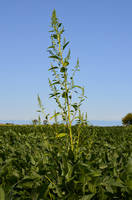Rough-fruited amaranth
Amaranthus tuberculatus
Appearance
Rough-fruited amaranth is an annual, herbaceous, dioecious plant that reproduces only by seed. The stems of the adult plants are erect, sometimes ascending, up to 200 (-300) cm tall, glabrous or sparsely hairy. Leaves are long-stalked, ovate, lanceolate-oblong (2-10 cm long, 1-3 cm wide), upper leaves reduced and narrow. Male and female flowers are on separate plants (dioecious), terminal inflorescences are 10-20 cm long with numerous panicled branches. Rough-fruited amaranth can be easily confused with other species of the foxtail family.
Distribution
The plant originates from North America and was probably introduced to Europe with contaminated grain and corn. Currently, larger populations of rough-fruited amaranth are found in northern Italy (e.g. Veneto) and Croatia. Isolated occurrences have been reported in Slovakia and Bosnia-Herzegovina. However, it can be assumed that the species is more widespread than previously thought. In Austria, there is anecdotal information from Styria dating back to the 1950s. Currently, however, there are no known occurrences of this plant in Austria. The species colonizes various habitats, such as river banks, wasteland and as a weed also agricultural crops such as corn and soybean.
Propagation and transmission
Rough-fruited amaranth has a very high seed production. One plant can produce up to 1 million seeds, which fall out in close proximity to the mother plant. Natural local dispersal of the very small and light seeds is most likely via water, as the seeds can float The seeds can be dispersed by raindrops and small rivulets in the soil. They can also be carried by machinery (combines). Current dispersal models show that climatically favorable regions are located in the south of Austria. The main limiting factor is low summer temperatures. The predictions of the models for the next decades indicate a strong increase of climatically favorable regions in Austria.
Economic importance
Rough-fruited amaranth is a significant weed in many agricultural crops because the species has many characteristics of an "ideal" weed and invader (i.e., high seed production, vigorous growth). However, the biggest problem is the development of herbicide-resistant biotypes. Such resistance has already been demonstrated to seven different modes of action in the United States. In this context, many biotypes exhibit more than one of these resistances, severely limiting the options for effective control ("superweeds"). Dioeciousness is thought to promote the spread of resistance. Resistant biotypes of the plant are already known from Italy.
Prevention and control
- Field observations in the risk areas in the south of Austria are necessary to localize the occurrence of these plants as early as possible
- Small populations are best removed by hand (digging)
- In agriculture, the plant can be controlled in the same way as other weeds by herbicides and mechanical control(list of plant protection products approved in Austria)
Specialized information
EPPO (2020) Pest risk analysis for Amaranthus tuberculatus. EPPO, Paris. Available at: https://gd.eppo.int/taxon/AMATU/documents
Last updated: 12.03.2024
automatically translated

